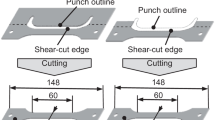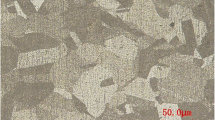Abstract
The blanking/trimming/cropping process introduces a substantial plastic deformation to the sheet metal and causes premature edge fracture during the subsequent forming process. In an attempt to understand how the blanking process affects edge fracture, an experimental and numerical study was undertaken on the plane-strain blanking process. Blanking tests on a DP780 steel sheet were carried out on a special fixture utilizing a in-situ microscope for the digital mage correlation (DIC) deformation measurement. The DIC method provides a detailed deformation field of the specimen that has not been reported in any other publications before. Interrupted tests were carried out to study the crack formation and propagation during the blanking procedure, while scanning electron microscope was applied to examine the blanked surface quality as well as the edge profile after test. Following the experimental study, a detailed finite element model with mesh size of 0.01 mm in the critical region was established for the numerical investigation. The model features (a) a non-associated Hill 48 flow rule, (b) von-Mises yield condition and (c) modified Mohr–Coulomb fracture model. With material parameters calibrated from the in-plane tests as well as accurate boundary conditions measured in actual tests, the finite element model accurately predicted the blanking process quantitatively. The current study also gave quantitative values of the parameters of interest during the blanking test, such as the global load displacement response and the local strain gradient history. The geometrical features of the blanked edge, i.e. the amount of roll over, the extent of the burnished zone and fracture zone were all accurately predicted by the present simulation.























Similar content being viewed by others
References
Bai Y, Wierzbicki T (2010) Application of extended mohr–coulomb criterion to ductile fracture. Int J Fract 161:1–20. doi:10.1007/s10704-009-9422-8
Cockcroft MG, Latham DJ (1966) A simple criterion of fracture for ductile metals. National Engineering Laboratory, UK, Report 216
Dalloz A, Besson J, Gourgues-Lorenzon T, Sturel AFand (2009) Effect of shear cutting on ductility of a dual phase steel. Eng Fract Mech 76(10):1411–1424
Dykeman J, Malcolm S, Yan B, Chintamani J, Huang G, Ramisetti N, Zhu H (2011) Characterization of edge fracture in various types of advanced high strength steel. Tech Rep, SAE Tech Paper
Goijaerts A, Stegeman Y, Govaert L, Brokken D, Brekelmans W, Baaijens F (2000) Can a new experimental and numerical study improve metal blanking? J Mater Process Technol 103(1):44–50
Golovashchenko SF (2006) A study on trimming of aluminum autobody sheet and development of a new robust process eliminating burrs and slivers. Int J Mech Sci 48(12):1384–1400
Golovashchenko SF (2008) Quality of trimming and its effect on stretch flanging of automotive panels. J Mater Eng Perform 17(3):316–325
Golovashchenko SF, Ilinich AM (2005) Trimming of advanced high strength steels. In: ASME 2005 international mechanical engineering congress and exposition, American Society of Mechanical Engineers, pp 279–286
Hambli R, Reszka M (2002) Fracture criteria identification using an inverse technique method and blanking experiment. Int J Mech Sci 44(7):1349–1361
Hu X, Choi KS, Sun X, Golovashchenko SF (2014) Edge fracture prediction of traditional and advanced trimming processes for aa6111-t4 sheets. J Manuf Sci Eng 136(2):021,016
Konieczny A, Henderson T (2007) On formability limitations in stamping involving sheared edge stretching. Tech Rep 2007-01-0340, SAE international, Warrendale. http://digitallibrary.sae.org.libproxy.mit.edu/content/2007-01-0340
Li M (2000a) An experimental investigation on cut surface and burr in trimming aluminum autobody sheet. Int J Mech Sci 42(5):889–906
Li M (2000b) Micromechanisms of deformation and fracture in shearing aluminum alloy sheet. Int J Mech Sci 42(5):907–923
Mohr D, Dunand M, Kim KH (2010) Evaluation of associated and non-associated quadratic plasticity models for advanced high strength steel sheets under multi-axial loading. Int J Plast 26(7):939–956
Rice JR, Tracey DM (1969) On the ductile enlargement of voids in triaxial stress fields. J Mech Phys Solids 17(3):201–217
Samuel M (1998) Fem simulations and experimental analysis of parameters of influence in the blanking process. J Mater Process Technol 84(1):97–106
Shih HC, Chiriac C, Shi MF (2010) The effects of ahss shear edge conditions on edge fracture. In: ASME 2010 international manufacturing science and engineering conference
Stegeman Y, Goijaerts A, Brokken D, Brekelmans W, Govaert L, Baaijens F (1999) An experimental and numerical study of a planar blanking process. J Mater Process Technol 87(1):266–276
Thipprakmas S, Jin M, Tomokazu K, Katsuhiro Y, Murakawa M (2008) Prediction of fineblanked surface characteristics using the finite element method (fem). J Mater Process Technol 198(1):391–398
Wang K, Luo M, Wierzbicki T (2014) Experiments and modeling of edge fracture for an ahss sheet. Int J Fract 1–24. doi:10.1007/s10704-014-9937-5, http://dx.doi.org/10.1007/s10704-014-9937-5
Wang K, Greve L, Wierzbicki T (2015) FE simulation of edge fracture considering pre-damage from blanking process. Int J Solids Struct. doi:10.1016/j.ijsolstr.2015.06.023
Zhou Q, Wierzbicki T (1996) A tension zone model of blanking and tearing of ductile metal plates. Int J Mech Sci 38(3):303–324
Acknowledgments
The authors want to thank Dr. Lars Greve for valuable discussions. Thanks are also due to Altair for providing free educational Hypermesh license which were used to prepare part of the finite element models used in the current study. We want to acknowledge the MIT Industrial Fracture Consortium for the funding support of the current study.
Author information
Authors and Affiliations
Corresponding author
Rights and permissions
About this article
Cite this article
Wang, K., Wierzbicki, T. Experimental and numerical study on the plane-strain blanking process on an AHSS sheet. Int J Fract 194, 19–36 (2015). https://doi.org/10.1007/s10704-015-0034-1
Received:
Accepted:
Published:
Issue Date:
DOI: https://doi.org/10.1007/s10704-015-0034-1




